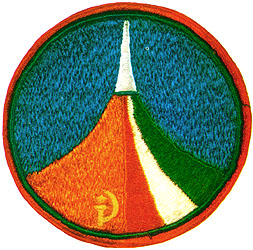
|
|

| Crew & Mission |
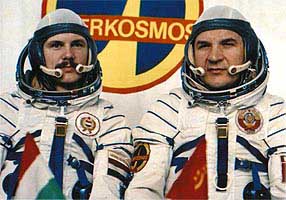 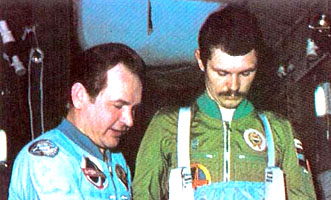 Left: Farkas and Kubasov wearing their training Sokols. The seals on their chests were only worn on the intravehicular clothing. The Interkosmos council patches shown here, are western script. On the actual Sokols, they were cyrillic for Kubasov and Hungarian for Farkas ("Interkozmosz"). The flags on their left sleeves were diferent as well: they were both without text. Right: The crew in TK-2 intravehicular training suits. Soyuz-36 was the fifth Interkosmos mission. the mission, with callsign was launched on March 26, 1980. Commander Valeri N. Kubasov and Hungarian Interkosmos cosmonaut Bertalan Farkas returned to Earth on -, 1980.
|
| The Artwork |
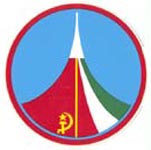 The Council for International Cooperation in the Exploration and Use of Outer Space (Interkosmos) was founded in 1976. Naturally, new emblems for uniforms and pressure suits were needed to reflect the cooperative nature of the missions. On December 14-15, 1977, a conference was held in Moscow by representatives of Bulgaria, Czechoslovakia, East Germany and the USSR, discussing the public relations aspect, the creation of the emblems and logos, and candidates for the flights. On December 23, 1977, Chairman B.I. Petrov of the Interkosmos council informed Zvezda General Director/Designer G. I. Severin announcing that Bulgaria, Czechoslovakia, and East Germany had agreed to participate in joint missions. Hungary was included later. The Council for International Cooperation in the Exploration and Use of Outer Space (Interkosmos) was founded in 1976. Naturally, new emblems for uniforms and pressure suits were needed to reflect the cooperative nature of the missions. On December 14-15, 1977, a conference was held in Moscow by representatives of Bulgaria, Czechoslovakia, East Germany and the USSR, discussing the public relations aspect, the creation of the emblems and logos, and candidates for the flights. On December 23, 1977, Chairman B.I. Petrov of the Interkosmos council informed Zvezda General Director/Designer G. I. Severin announcing that Bulgaria, Czechoslovakia, and East Germany had agreed to participate in joint missions. Hungary was included later. |
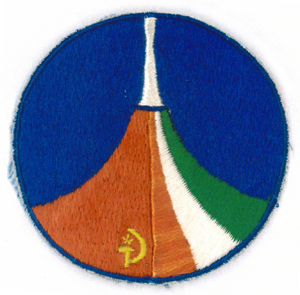 Like with many Interkosmos missions, several prototypes of patches were produced. This variation shows the Soyuz 36 design with just a narrow blue border, instead of the green-red border used in the flight version. Like with many Interkosmos missions, several prototypes of patches were produced. This variation shows the Soyuz 36 design with just a narrow blue border, instead of the green-red border used in the flight version. |
| The Real Thing |
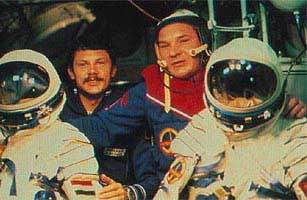 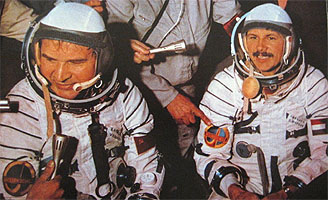 Farkas and Kubasov posing aboard Salyut-6 in their intravehicular suits, showing their flight Sokols (l). At right: The cosmonauts at the landing site in the same Sokols. Both flags are without text.
The joint mission patch was worn on the right sleeve of the intra-vehicular suits. The Interkosmos council logo (yellow/red, cyrillic and Hungarian versions) were worn on the right lower torso, with the Soviet and Hungarian seals at the upper left chest. On the Sokol suits, the Interkosmos council patch was worn on the right sleeve. On both suits, the flags were worn on the left sleeve. The Soviet flag was a silk type on the Sokol and an unknown version on the intravehicular suit. The Hungarian flag was without text on the Sokol and also of an unknown version on the intravehicular suit. |
| Collecting Soyuz-36 |
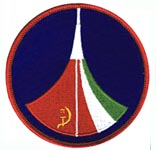 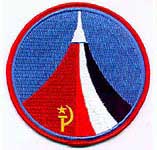 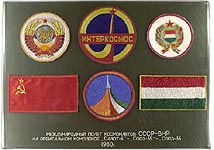 Left: The Space Commerce Corporation reproduction. Center: The Stewart Aviation reproduction. Right: The Patch presentation Set.
The patch was probably designed and produced by the Zvezda corporation. Two souvenir versions were made in the West by Stewart Aviation in England and Space Commerce Corporation in the United States. Two related patches were produced by Eagle One Aerospace. The Stewart Aviation version (with black insetad of green...) is still in their catalogue; the SCC version is offered every now and then on eBay and the EOA-version might still be available from Cargo Bay Emblems. The original Soviet-made patch was made available to officials as part of a Presentation Set, which is scarcely seen in auctions.
|